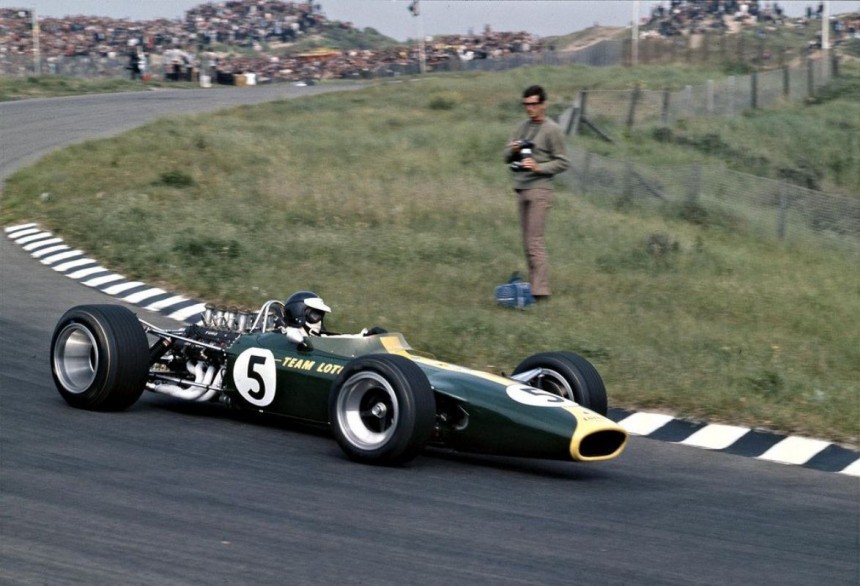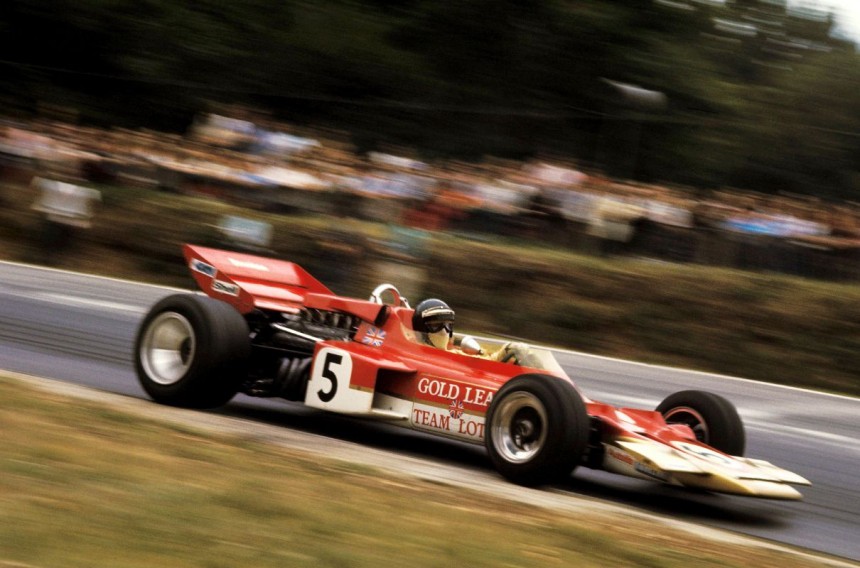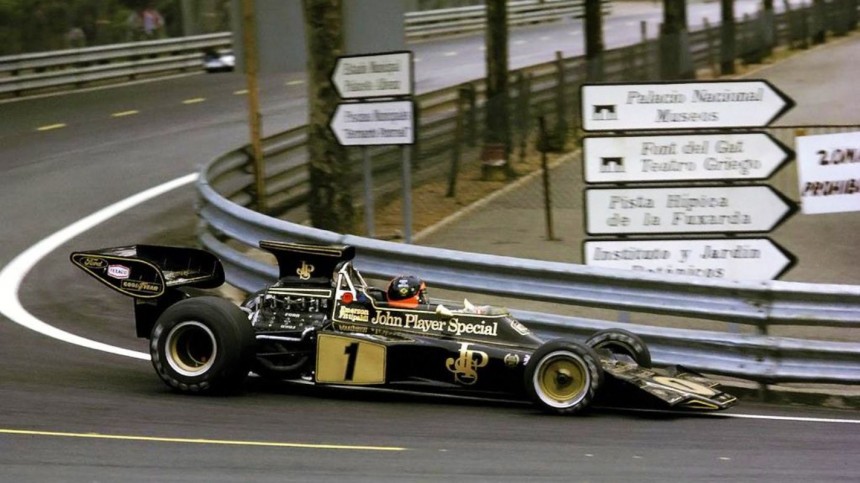In the 1970s, Lotus and a guy called Colin Chapman introduced a car that would shock and change the world of Formula 1 for good. Today we will look at this vehicle's history and how much it influenced F1.
The Lotus we are talking about was so dominant and successful that it competed in six seasons between 1970 and 1975. In those years, it won three Constructors' titles, two Drivers' Championships (Jochen Rindt in 1970 and Emerson Fittipaldi in 1972), 20 race wins, and many more performances. Of course, it could only be the Lotus 72, one of the most successful F1 vehicles of all time.
The story of the '72' goes back as far as 1962, with the creation of the Lotus 25. Until this point, all F1 cars had used a tubular frame design for their chassis, but the genius engineer Colin Chapman realized that a different method could be better. His unique idea was to create a U-shaped monocoque structure that carried the fuel tanks, engine, and cockpit. The main idea was that the new chassis design would allow the car to be lighter with a lower center of gravity, while, at the same time, would still be rigid enough for the extreme demands of Formula 1 racing.
The new vehicle developed by the British engineers would have its first outing in the 1962 Dutch Grand Prix, at the Zandvoort circuit. And who would test the 25 model better than legendary driver Jim Clark? While he hadn't won any championships at that moment, he was a rising star and already very respected by his rivals.
In 1962, he was close to winning the Drivers' titles, but Graham Hill outperformed him. The following season, Jim Clark and Lotus dominated almost every Grand Prix weekend, winning seven out of ten races. More success will come in 1964, but the British team would have to wait until 1965 to reclaim both championships. The team's dominance would come to an end with the introduction of the new regulations that allowed for engines up to three liters in size. While Colin Chapman and the Lotus squad had some success in this larger engine era, they needed help finding a suitable power unit for their car.
Instead of opting for a vast and massive 3.0-liter V12 like many other teams, Colin wanted a slightly smaller, more efficient power unit for their next car, named the 49. Chapman went to Cosworth to ask for help in order to achieve his goal. While the British company was more than desirable to assist and help, the development cost would be high. Fortunately, Colin, Harley Kopp, and Walter Hayes eventually managed to convince Ford UK's chairman to fund the project.
As a result, the Ford Cosworth engine was revealed in all its glory at the end of 1965. However, it would not be race ready until the third Grand Prix of the 1967 Formula 1 season. Still, it was worth the wait, because the V8-powered Lotus 49 destroyed and demolished the rest of the grid in the qualifying sessions. They were winning by a considerable margin in the race, more than a full lap with Jim Clark at the wheel. In contrast, Graham Hill, the man behind the wheel of the second 49, would not be so lucky. Because as successful as this car was, reliability was a huge problem. Funny enough, the story of massive success is strongly tied to race-ending reliability problems. It was a common theme for Lotus 49 throughout the season.
As a result, Jim Clark would win three more races in the car, but reliability issues would destroy the hopes for a championship. In 1968, the British team repaired all the problems, and they were back in form. As a result, Graham Hill won his second Drivers' Championship after the 1962 title. Unfortunately, this was marred by the loss of Jim Clark at a Formula 2 event in Germany.
By the end of the 1960s era, it was becoming pretty clear that a good engine combined with an excellent chassis wasn't enough to win a world title. Aerodynamic wings and features were making big waves in the world of motorsport, and Sir Colin Chapman realized that his next car, the 63, would have to take advantage of the effects of air. Unfortunately, the new vehicle performed so badly that an improved version of the 49 had to be modified to get the team back on top. Lotus needed a revolution that fortunately came.
The designer's new creation would be called, you guessed, the Lotus 72. Compared to the old models, the new car was radically different. For example, the position of the radiator was moved from the front of the vehicle to two smaller ones on either side of the chassis. While it might not seem like a huge change, it significantly improved the aerodynamic performance and helped with weight distribution. In addition, it also enhanced the traction at the rear wheels, the entire front suspension system was reworked, and the disc brakes were moved inboard, shifting weight from the outside of the wheels towards the center of the Lotus.
Another exciting feature of the new Lotus 72 was its anti-dive geometry at the front that prevented the car from dropping its nose under hard braking. This was combined with an anti-squat system at the rear to avoid front-end lift during acceleration and thus give a consistent aerodynamic performance. All of the suspension components were attached to an aluminum monocoque chassis that was significantly lower to the ground than the ones on the team's previous cars.
From a visual standpoint, the biggest visual change was the addition of two wings at the front and a massive rear wing, that was the largest scene yet on a Formula 1 vehicle. The Ford Cosworth V8 engine and a five-speed manual transmission pushed the Lotus to 420 hp (426 ps). The 72 first showed up at the 1970 Spanish Grand Prix with Jochen Rindt and John Miles at the wheel.
The expectations were huge, but the Lotus 72 did not have the greatest start. The design team made some changes, and Jochen Rindt took four wins in a row from the Dutch Grand Prix. At the British Grand Prix, the 72 will receive a top-mounted air box, another first for a Formula 1 car. Rindt had a massive lead over everybody, but tragedy struck at the Italian Grand Prix. The championship leader was testing the 72C during free practice with a low downforce setup that was better suited to the high speeds of the track. Under braking, the Lotus snapped to the left and smashed into the safety barriers. He was pronounced dead on the way to the hospital and became the first and only posthumous champion in F1 history.
Emerson Fittipaldi replaced Jochen, and by 1972 the team was back on top after upgrading the Lotus 72 once more. With the legendary black and gold livery, Fittipaldi won five races and became the youngest champion at that time. In 1973, Ronnie Peterson was hired, and together with Emerson, they helped Lotus win their third Constructors' title in four years. In the following season, the aging 72 still managed to achieve four wins after many upgrades and reservices.
While the Lotus 72 would have a disappointing final season, nothing could take away from its incredible achievements over its six years in the competitions. It would go on to become one of the most iconic race cars of all time and one of the most successful F1 to date.
The story of the '72' goes back as far as 1962, with the creation of the Lotus 25. Until this point, all F1 cars had used a tubular frame design for their chassis, but the genius engineer Colin Chapman realized that a different method could be better. His unique idea was to create a U-shaped monocoque structure that carried the fuel tanks, engine, and cockpit. The main idea was that the new chassis design would allow the car to be lighter with a lower center of gravity, while, at the same time, would still be rigid enough for the extreme demands of Formula 1 racing.
The new vehicle developed by the British engineers would have its first outing in the 1962 Dutch Grand Prix, at the Zandvoort circuit. And who would test the 25 model better than legendary driver Jim Clark? While he hadn't won any championships at that moment, he was a rising star and already very respected by his rivals.
In 1962, he was close to winning the Drivers' titles, but Graham Hill outperformed him. The following season, Jim Clark and Lotus dominated almost every Grand Prix weekend, winning seven out of ten races. More success will come in 1964, but the British team would have to wait until 1965 to reclaim both championships. The team's dominance would come to an end with the introduction of the new regulations that allowed for engines up to three liters in size. While Colin Chapman and the Lotus squad had some success in this larger engine era, they needed help finding a suitable power unit for their car.
As a result, the Ford Cosworth engine was revealed in all its glory at the end of 1965. However, it would not be race ready until the third Grand Prix of the 1967 Formula 1 season. Still, it was worth the wait, because the V8-powered Lotus 49 destroyed and demolished the rest of the grid in the qualifying sessions. They were winning by a considerable margin in the race, more than a full lap with Jim Clark at the wheel. In contrast, Graham Hill, the man behind the wheel of the second 49, would not be so lucky. Because as successful as this car was, reliability was a huge problem. Funny enough, the story of massive success is strongly tied to race-ending reliability problems. It was a common theme for Lotus 49 throughout the season.
As a result, Jim Clark would win three more races in the car, but reliability issues would destroy the hopes for a championship. In 1968, the British team repaired all the problems, and they were back in form. As a result, Graham Hill won his second Drivers' Championship after the 1962 title. Unfortunately, this was marred by the loss of Jim Clark at a Formula 2 event in Germany.
By the end of the 1960s era, it was becoming pretty clear that a good engine combined with an excellent chassis wasn't enough to win a world title. Aerodynamic wings and features were making big waves in the world of motorsport, and Sir Colin Chapman realized that his next car, the 63, would have to take advantage of the effects of air. Unfortunately, the new vehicle performed so badly that an improved version of the 49 had to be modified to get the team back on top. Lotus needed a revolution that fortunately came.
Another exciting feature of the new Lotus 72 was its anti-dive geometry at the front that prevented the car from dropping its nose under hard braking. This was combined with an anti-squat system at the rear to avoid front-end lift during acceleration and thus give a consistent aerodynamic performance. All of the suspension components were attached to an aluminum monocoque chassis that was significantly lower to the ground than the ones on the team's previous cars.
From a visual standpoint, the biggest visual change was the addition of two wings at the front and a massive rear wing, that was the largest scene yet on a Formula 1 vehicle. The Ford Cosworth V8 engine and a five-speed manual transmission pushed the Lotus to 420 hp (426 ps). The 72 first showed up at the 1970 Spanish Grand Prix with Jochen Rindt and John Miles at the wheel.
The expectations were huge, but the Lotus 72 did not have the greatest start. The design team made some changes, and Jochen Rindt took four wins in a row from the Dutch Grand Prix. At the British Grand Prix, the 72 will receive a top-mounted air box, another first for a Formula 1 car. Rindt had a massive lead over everybody, but tragedy struck at the Italian Grand Prix. The championship leader was testing the 72C during free practice with a low downforce setup that was better suited to the high speeds of the track. Under braking, the Lotus snapped to the left and smashed into the safety barriers. He was pronounced dead on the way to the hospital and became the first and only posthumous champion in F1 history.
While the Lotus 72 would have a disappointing final season, nothing could take away from its incredible achievements over its six years in the competitions. It would go on to become one of the most iconic race cars of all time and one of the most successful F1 to date.













